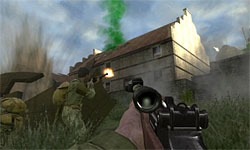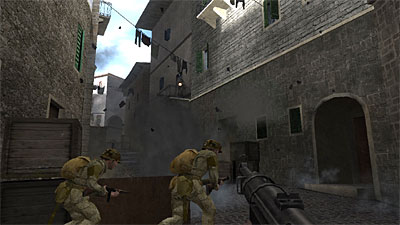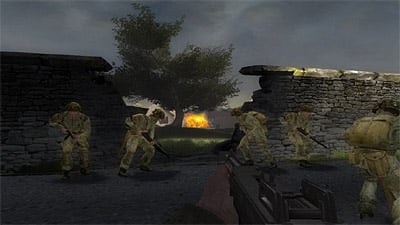World War Wii
It has been said over and over. World War II games have been done to death. Regardless of the average gamer’s frustration with having to revisit the era time and again, developers continue to focus their shooting games in the second World War. If they plan on revisiting this era for another hundred games, developers are going to have to create a game that seriously revitalizes the experience. Unfortunately, Medal of Honor Vanguard is not that game. Vanguard provides gamers with another mediocre World War II Shooter in a market that is already crowded with mediocre WWII shooters.

In Vanguard, you’re Corporal Frank Keegan, a member of the 82nd Airborne division. The game begins on a pessimistic note, emphasizing how cynical everyone was about the possible effectiveness of the first Airborne Division. As Keegan, you start the game with your team on the way to your drop, but the entire team is forcibly thrust from their aircraft before they are ready. Fortunately enough, they’re able to open their parachutes and make their way to the battlefield. However, gameplay itself begins with the parachuting, which is a fairly unique approach to the battle incursion. Usually war games force the player to sit through the incursion, even though it is often shown through the protagonist’s eyes to maintain the feel of the FPS. Vanguard, however, allows you to control your parachuting, adding a very slight element of strategy to where you begin your fighting that is immediately negated by the limits the game places on your landing area. Another flaw is that occasionally, if you land in the wrong place, you can be killed by the enemy before your character is even controllable, as there is a brief period when Keegan must get his footing after landing.
The Wii version of Vanguard attempts to utilize the Wii’s motion sensing controls to create a more immersive gaming experience for the genre, and although the attempt is admirably implemented, it isn’t quite successful. The parachuting feels natural, as you hold the Wii-mote and Nunchuk upright to simulate holding your straps and move them to change the direction of the fall. While in battle, the Nunchuk controls movement while you target with the Wii-mote. The controls aren’t as tight as they should be in either case. A flick to the right with the Nunchuk reloads and a flick to the left initiates a 180 degree turn for quick retreats. With grenades equipped, a tossing motion with the Wii-mote throws the explosives, and a stabbing motion makes the protagonist execute a melee attack. The problem is that a lot of these controls are imprecise, as the game seemed to have trouble distinguishing when I wanted to reload or turn around. In a heated battle, this can mean the difference between life and death. The aiming reticule can also become floaty at times as well, making the overall controls feel too loose.

Graphically, Vanguard doesn’t impress at all and helps to establish the game’s feeling of mediocrity. While most of the game’s visuals aren’t bad, they don’t stand up to close scrutiny and never, at any point in the game, impress. On the other end of the spectrum, the sound effects, voice acting, and soundtrack are pretty good, although again there isn’t anything spectacular here. One particularly bad element of the sound, however, comes when a grenade explodes near you. There is a good effect of hearing loss, with all the game’s sounds being replaced by the high whining that follows an explosion, but the effect only lasts for a second or so, with the hearing being restored too swiftly to create any sense of danger or true damage.
Medal of Honor: Vanguard battles are always generally up to you to finish. Your comrades are, for the most part, obstacles that usually block you from having a clean shot at the enemy. They do, however, announce enemy locations with pretty decent efficiency. This is to their own benefit since they can’t win any battles without you. Your teammates have absolutely horrendous marksmanship and it’s rare that they actually kill opponents even amidst the unrelenting gunfire. Enemy soldiers also lack any sort of appreciable A.I. They’ll run to cover and you basically can set your sights on whatever they’re hiding behind to patiently pick them off when they poke their head out.

There is split screen multiplayer for replayability. However, it is saddled with the same feeling of mediocrity that plagues the single player campaign so it isn’t the best multiplayer experience available, especially considering that it is split-screen and offline.
Overall, Medal of Honor: Vanguard just feels dated and unoriginal. Even by including Wii controls, Vanguard doesn’t do anything to make the game stand out from any of the other dozens of WWII games out there, many of which are much more fun. If, because of some obsession, you have to play every WWII game, pick up MoH: Vanguard. For everyone else, you won’t find anything at all new here.
Features:
|
